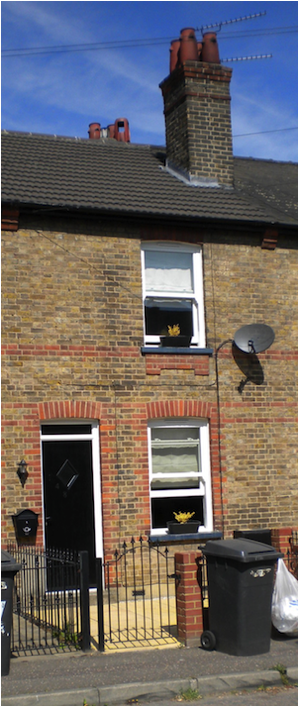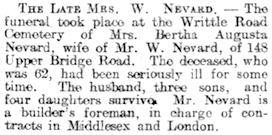Harold Percival Nevard was born in London and moved to Chelmsford by 1913. He joined the army and landed in France in May 1915. He was killed in action at the Battle of the Somme in July 1916. His home was in Upper Bridge Road.
NEVARD, HAROLD PERCIVAL,
Private, 9th (Service) Battalion, Essex Regiment
This difficulty notwithstanding, however, the leading battalions over-ran the enemy’s front and support lines and parties entered Ovillers, together with men of the 9th Essex. The latter unit had suffered severely whilst crossing the open ground by machine gun fire from the flanks and the village, and the waves became a series of detached parties under either an officer or N.C.O. A, D and three plattons of B Company had advanced in platoon waves, but the lines were not always in touch, the initial cause being the difficulty of getting the companies deployed along the front trench so as to move simultaneously owing to their damaged condition and the number of wounded and other details making their way back by the communication trenches up which the 9th Essex had groped their way.
Two platoons of B Company got over the German front line and where then held up by a high command Circular Trench which overlooked the ground they had won. The remainder of B Company and A Company almost reached the German line and were then held up by machine gun fire from Circular Trench which had stayed the advance of the other portion of B Company. D Company also made progress on the left, but they too, were stopped by the machine guns of Circular Trench, the wire of which had been renewed after the British bombardment had ceased.
Survivors from the enemy front line had sought shelter in this miniature fortress when the Brigade advanced and delivered therefrom the bombing attacks which were to have a potent effect on staying the Brigade’s offensive. The first to feel the influence of thus counter-attack were the two plattons of B Company, which were forced back. sadly depleted to the German front line.
Battalion headquarters had been in the meantime moved to the junction of St. Vincent Street and Border Street, and no information having come to hand, Lieut.-Colonel Lewes and Adjutant went forward to ascertain the situation. Parties could be seen coming back on the right of the 36th Brigade, which had attacked with the 35th Brigade.. and later other parties sought to return on the right flank of the Brigade.
A small detachment of the Essex, about fifty men, started digging in on a small ridge or bank which overlooked the enemy’s first line and extra tools for that purpose were sent up by the 7th Norfolks. Information was very difficult to obtain and of news of the exact whereabouts of the Berkshires and Suffolks there was none. About 4 a.m. the attack had come to a standstill and the survivors withdrew again to the front line.. where the 7th Norfolks took over and enabled the Essex to reorganise in Ribble Street.
A curious mistake occurred during the attack, which deprived the Battalion of C Company (Kennefick), but which had, by happy mischance, the fortunate result of materially assisting the capture of La Boisselle. C Company were on the left of B Company and should have advance in line with them, but they lost touch and, moving in a south-easterly direction in lines of platoons. straight across Mash Valley, tehy struck the German lines north-west of La Boisselle. They carried the enemy front and support trenches and went right through the village, where they met the Royal Welsh Fusiliers and Gloucesters, of the 19th Division, who were advancing upon La Boisselle from the opposite direction.
Much bomb fighting ensued in the village and when C Company were withdrawn at 2 p.m. only the north-western corner remained in German occupation. C Company secured 150 prisoners in their bold essay, who were handed over to the 19th Division for safe conduct to Albert. Thus, although Ovillers remained untaken, La Boisselle, another strongly fortified point in the line, had succumbed to the bold attack of C Company. ‘Though there was a grave error’, wrote the Battalion Commander, ‘in the initial leading and the attack on Ovillers was deprived of a whole company, which may or may not have made all the difference, I would like to point out that the handling and conduct of the Company from this point were most creditable, especially as it was considerably shaken by the bombardment of our trenches just before the attack from which Furness Street suffered badly’...Twelve officers and 386 other ranks were returned as casualties or missing.”
At some during that day, the 3rd July 1916, Harold was killed in action, one of 110 men from the Battalion who are listed as killed that day by the Commonwealth War Graves Commission. He was aged 21. Another Chelmsford man, also serving in the 9th (Service) Battalion of the Essex Regiment, William Thomas Hoggart, was killed that day.
Harold has no known grave and is commemorated on the Thiepval Memorial, near Albert, Somme, France, and on the Civic Centre Memorial, Chelmsford. He was not commemorated by the war memorial at St. John’s Church, Moulsham.
Harold was entitled to the 1914-15 Star, British War Medal, and Victory Medal.
The 1918 register of electors recorded Harold’s parents still resident at 148 Upper Bridge Road, and his father remained there until at least 1929. His mother died in 1935, aged 62.
161113

Harold was born at Hornsey in Middlesex in 1896, the second son of the plumber William John Nevard and Bertha Augusta Nevard (nee Poduschnick).
Harold’s father had been born in 1873 in Camberwell, Surrey; his mother in 1873 in Islington, London. They had married in 1895 in London.
Harold was one of nine children born before 1911, three of whom were to die by 1911. His siblings included Stanley Marcus Nevard (born in 1899 in Manor Park, died in 1970); Daisy Edith Nevard (born in 1902 in Manor Park, died 1973); Gordon Denis Nevard (born in 1905 in Manor Park, died in 1970); Ivy Bertha Nevard (born in 1908 in Laindon, died in 1995), and Lillian Patricia Nevard (born in 1910 in Corringham); Other later siblings were Victor A. Nevard (born and died in Chelmsford in 1914) and Myrtle G. Nevard (born in Chelmsford in 1920, died in 2010).
At the time of the 1901 census Harold was living with his parents and a brother at 197 Sixth Avenue, East Ham. His father was a plumber. A decade later the 1911 census listed 15 year-old Harold living with his parents and five siblings in Corringham. Harold was a grocer’s assistant and his father remained employed as a plumber.
A 1913 street directory showed the Nevard family at 148 Upper Bridge Road, Chelmsford (pictured).
Harold lived in Chelmsford. He enlisted at Southend-on-Sea and served as Private 10632 with the 9th (Service) Battalion of the Essex Regiment, a ‘New Army’ battalion that had been formed at Warley in August 1914. It was attached to 35th Brigade in the 12th (Eastern) Division. Harold landed with his battalion at Boulogne, France at the end of May 1915.
A month later the 12th (Eastern) Division, including Harold’s battalion, took over a sector of the front line for the first time at Ploegsteert Wood. In September 1915 it participated in the Battle of Loos.
In July 1916 Harold’s battalion took part in the Battle of the Somme. A post war
regimental history reported:
“The Battalion was in reserve at Henencourt Wood [west of Albert] during the eventful daylight hours of July 1st. At 6.30 p.m. it moved through the village, the march being hampered by the blocking of the roads to Albert by other troops also marching up to the line in relief of the 8th Division, which had suffered severely. The 9th Essex occupied the line opposite Ovillers [north-east of Albert] on July 2nd. They were in support of the 5th Royal Berks and 7th Suffolks and during the day took shelter in the railway cutting near Marmont bridge from possible hostile counter bombardment whilst the 19th Division was operating against La Boisselle.
Orders were received that the Brigade was to attack Ovillers in the early morning of July 4th, but the time was subsequently altered to 3 a.m. on the 3rd , which prevented the thorough reconnaissance of the ground which had been planned. The Battalion occupied the following communication trenches - B Company in St. Vincent, C Company in Furness Street, A Company in Barrow Street and D Company in Mitchell Street, with Battalion headquarters in Ryecroft Street. Each company had its head in touch with the rear platoons of the leading battalion of the Brigade. Berkshires and Suffolks assembled in Border Street.
‘The march of the Battalion’. wrote a member of the 9th, ‘to take up position in this first Somme battle will for ever be remembered by those engaged. Innumerable gun flashes lit the darkness of the night; they seemed endless and as one approached the line, the noise was deafening. After what appeared to be endless marching we reached the trenches in front of Ovillers. They were of hard chalk and with the bad weather not all that easy to negotiate without trench boards. In moving to positions for attack, the congestion in the trenches was awful and mortally wounded men could not be moved, Zero hour arrived when it was raining, visibility was poor, with bitter retaliation by way of machine gun fire from the enemy’.
At 2.15 everything was ready, when a message was received that zero hour had been changed to 3.7 a.m. The attack took place promptly to time after a heavy bombardment and at 3.20 a.m. the leading lines of the Battalion followed in support. Considerable difficulty had been experienced in reaching the front line and the last of the Berkshires and Suffolks had disappeared into the darkness before the first Company had leapt the parapet in support. The direction of the attack was 90 degrees magnetic; that is to say, in a quarter left direction from the front line. Direction was not well maintained, chiefly because the objectives were indistinguishable and the jumping-off places were not square to the enemy line.

